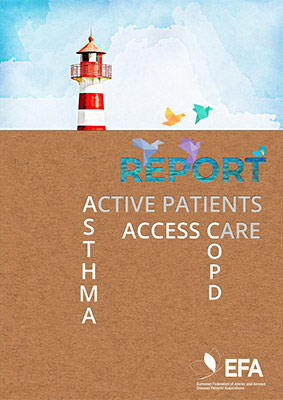Despite significant improvements in health in the last decades, unequal access to healthcare in Europe remains a problem for asthma and COPD patients. In 2018, EFA decided to #ShowLeadership and get the state of play for asthma and COPD, by asking 774 patients from Finland, France, Germany, Italy, Poland, Spain and the UK, about accessing their disease needs.
 The resulting EFA Active Patients ACCESS Care survey report, published in 2019, gives an overview of patient-reported levels of access to Diagnosis, Care, Prevention, Patient Empowerment and Research in Europe, highlighting asthma and COPD patients’ care choices and priorities as well as describing key issues that affect patients’ quality of life.
The resulting EFA Active Patients ACCESS Care survey report, published in 2019, gives an overview of patient-reported levels of access to Diagnosis, Care, Prevention, Patient Empowerment and Research in Europe, highlighting asthma and COPD patients’ care choices and priorities as well as describing key issues that affect patients’ quality of life.
The report provides with comparable patient-reported outcomes that show that asthma and COPD are not being adequately addressed, whether diagnosis is taking so long or patients are not able to self-manage correctly, we identified persisting gaps of access to good quality care for patients and provided recommendations for decision-makers, care-providers, researchers and patients to overcome these gaps.
EFA presented the results at the European Respiratory Society (ERS) Congress in Madrid. We also published seven country fact sheets highlighting most relevant national data. As the report puts forward recommendations to overcome gaps, those were highly promoted alongside results in the #ShowLeadership campaign. The report has got an overall social media reach of 240,000 and was downloaded 140 times.
Active Patients ACCESS Care
- COPD and asthma patients received on average their first diagnosis after 3,4 and 3 years, respectively.
- 16% of asthma and COPD patients initially received a wrong diagnosis and it took 5,2 year and 4,5 years for COPD and asthma patients, respectively, to receive the correct diagnosis.
- Asthma and COPD patients are aware of what triggers their health condition, especially when it comes to individual risk factors like stress or obesity, and outdoor and indoor air pollutants. Nevertheless, only 34% of the patients are satisfied with Government efforts to protect them against risk factors.
- 32% of asthma and COPD patients do not feel involved in decisions on their therapy. Less than half of respondents have a self-management plan and many patients with COPD (33%) or asthma (20%) indicate that they have “never heard about” self-management plans.
- Asthma patients reported that their disease is most commonly treated with inhaled corticosteroids (72%) and emergency relief (62%) medication. The most common pharmacological treatments used by COPD patients are emergency relief spray (SABA) and reliever (LABA).
- Asthma and COPD patients visit quite often their doctor. The majority of asthma patients (53%) have up to 5 visits per year whereas 52% COPD patients see their doctor more than 6 times per year. The frequency of visiting healthcare professionals increases with the severity for both diseases.
